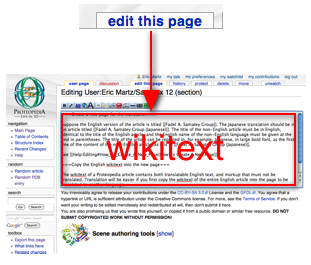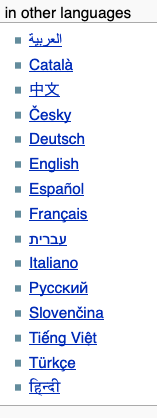Help:Language Translation
From Proteopedia
This article offers a guide for how to translate an article (a page) in Proteopedia to another language, for example from English to Japanese. The main language of Proteopedia is English. There are no plans to have complete parallel Proteopedias in non-English languages. (In contrast, Wikipedia maintains parallel versions in many languages.) However, translation of English articles in Proteopedia to non-English languages is welcomed.
Rules and policies for non-English articles in Proteopedia will be found at Proteopedia:Languages.
Of course, the English and non-English versions of an article will likely diverge as each is edited independently after the initial translation. While such divergence is undesirable, this problem seems to be outweighed by the value of having some articles in non-English languages. If you decide to translate a page, please add the original page to the list of your watched pages, to get notified by email when the original page changes.
Contents |
Preparation
Create a new page for the translation
Suppose the English version of the article is titled Fadel A. Samatey Group. The Japanese translation should be in an article titled Fadel A. Samatey Group (Japanese). The title of the non-English article must be in English, identical to the title of the English article, and the English name of the non-English language must be given at the end in parentheses. The title of the article can be repeated in, for example, Japanese, in large bold font, as the first line of the content of the non-English article, as it is in Fadel A. Samatey Group (Japanese).
Translate the title of the page
The wikitext of a Proteopedia article is the editable text and markup that appears in the box after you click the tab edit this page (see image at right).
Delete everything in the wikitext box of your new page.
In the new page, put a translation of the English title inside the wikitext box, at the top. Use markup that will make the translated title large and bold. See the example at Fadel A. Samatey Group (Japanese). There, click edit this page, then copy the first line of this page into your new page.
Replace the Japanese in the copied line with the translation of the title of your page.
Mark the translation as being available in English
Included at the end of the title line that you copied above is markup that specifies that this page is available in English:
- [[en:Fadel A. Samatey Group]]
Change the black part of the above markup to the name of the page in a different language. Do not change any of the yellow background parts.
This markup does not show on the page. Rather, it generates a link to the other page at the left bottom, below the toolbox, like this:
For a highly-translated page, Aricept Complexed with Acetylcholinesterase, it looks like this:
Save the page and test the in other languages link to make sure it works. If it goes to the Main Page, or the wrong page, then you need to correct the title of the page in the markup.
2-Letter Language Codes
Here is a link to a list of the two-letter codes for 184 languages. The article Interlanguage Links explains this markup, and the article ISO 639 has links to additional information and language lists. Please write to ![]() if the 2-letter language code you want does not produce the interlanguage link on the left hand side toolbar.
if the 2-letter language code you want does not produce the interlanguage link on the left hand side toolbar.
Copy the English wikitext into the new page
The wikitext of a Proteopedia article contains both translatable English text, and markup that must not be translated. Translation will be easier if you first copy the wikitext of the entire English article into the page to be translated to another language. For this procedure we'll use the example of translation from English to Japanese.
- At the English page, click the tab edit this page. You will see the wikitext.
- Click in the wikitext box.
- Edit, Select All.
- Edit, Copy.
- Cancel editing of the English page.
- Open the Japanese page in another browser tab or window.
- Click the tab edit this page.
- Place the cursor in the wikitext box where the English text and markup to be translated should be pasted, for example, below the Japanese title in the wikitext box.
- Edit, Paste.
- Save the Japanese page.
Translation
Plain text can be translated. It is important not to translate markup.
Save Early And Often
By mistake, you might change some markup characters. When you save the page, the display will be broken. If you have changed many lines of wikitext, you may not be able to find where the markup is broken. (In that case, please stop and email for help, ![]() .)
.)
Please make one small change at a time -- one markup or one sentence. Then save and be sure the display is OK. If it is broken, you will know where the problem is.
If you save a page and get XML Error: Mismatched tag at line 1, don't worry, you can recover your page: see Help:Errors.
Markup Examples
Be careful not to translate markup. Below are some examples. Text in yellow background must not be translated. The black needs to be translated.
- Pay careful attention not to damage critical markup codes such as | (vertical bar), [ , [[ , * , etc. If you have any questions, please feel free to email
 .
.
Links
Many of the links in a Japanese Proteopedia page will go to English pages. We recommend translating the displayed labels of these links to Japanese, because the purpose of a Japanese page is for readers who are not skilled in English. By translating the displayed labels of the links, these readers have a better idea what is being linked, even though when they click the link, they may be taken to an English page. If you wish, you could indicate this by adding "(English)" to the name of the link.
For example, a link to an article titled X-ray crystallography will have the displayed label X-ray crystallography in the English article. In the Japanese article, it can be translated to X線回折 (English), or X線回折 (英語).
In these examples, translate only the black parts:
- [[User:Fadel A. Samatey|Fadel A. Samatey]]
- Above is a link to another article/page within Proteopedia. Note the vertical bar | that separates the translatable text from the markup.
- [http://www.oist.jp/en/research/research-units/unit-transmem-traffick.html Transmembrane Trafficking Unit]
- Above is a link to a site outside of Proteopedia. Note the space that separates the address (URL) from the translatable text.
- [[#Contributions from OIST|Below]]
- [[X-ray crystallography]]
- Change a link like this to [[X-ray crystallography|X-ray crystallography]], and translate the black portion, being careful to insert the vertical bar | between the English and non-English titles.
Literature References
References to scientific literature generally cannot be translated because they are generated from a PubMed ID number, for example:
- electron cryomicroscopy<ref name="hook1">PMID:15510139</ref>
becomes a footnote number
- electron cryomicroscopy[1]
linked to an automatically-generated literature citation
- Samatey FA, Matsunami H, Imada K, Nagashima S, Shaikh TR, Thomas DR, Chen JZ, Derosier DJ, Kitao A, Namba K. Structure of the bacterial flagellar hook and implication for the molecular universal joint mechanism. Nature. 2004 Oct 28;431(7012):1062-8. PMID:15510139 doi:http://dx.doi.org/10.1038/nature02997
- <ref group="xtra">PMID: 21301106</ref><references group="xtra" />
- There is nothing to translate here.
Other Markup
Translate only the black parts. Do not change the parts with yellow background.
- <table align="right" width="260" ><tr><td rowspan="2"> </td><td>[[Image:Flagellar hook em density 1ucu.jpg]]</td></tr><tr><td><font color="#00908c">Crystal structure of flagellar hook</font> fitted into <font color="magenta">electron density map</font> obtained by electron cryomicroscopy<ref name="hook1">PMID:15510139</ref>.</td></tr></table>
- :<table style="background: #ffd0b0;padding: 6px;"><tr><td>Analyses the mechanism by which monomers of the '''[[Flagellar hook of bacteria|flagellar hook]]''' slide against each other during hook rotation, to permit bending while transmitting torque.</td></tr></table>
- A colon ":" as the first character in a line causes indentation of that line.
- <Structure size='200' frame='true' align='right' caption='[[Flagellar filament of bacteria|Flagellar filament]] monomer, [[1io1]].' scene='User:Eric_Martz/Workbench/Samatey_Group/Flag_fil_monomer/1' />
- A <Structure ...> tag inserts a Jmol into the page. Only the caption can be translated.
- <!-- (some text) -->
- This is a comment. It does not display. No translation is needed.
Completion
Link the Translation to the Source Article
1. Put the interlanguage link markup at the top of the source article, indicating the new language in the translated article.
2. You may also wish to put a link in the new language, to the translated article, at the top of the English article. For an example, see Fadel A. Samatey Group.
See Also
- Proteopedia:Languages concerning rules and policies.
- Help:Text Directionality concerning languages that read from right to left.



